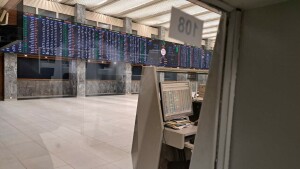 NEW YORK: Long-dated US Treasury debt prices fell on Thursday as investors pared bond holdings in advance of a key government jobs report, which might top expectations following recent data suggesting a resilient US economy.
NEW YORK: Long-dated US Treasury debt prices fell on Thursday as investors pared bond holdings in advance of a key government jobs report, which might top expectations following recent data suggesting a resilient US economy.
A rebound in the US stock market this week pointed to revived risk appetite among investors, although nagging worries about the European debt crisis hurting the US economy limited the decline in Treasuries prices.
"Equities are doing better, but there's no resolution in Europe. There is no definitive trend in any of these markets," said Laura LaRosa, director of fixed income at Glenmede, in Philadelphia, Pennsylvania, which manages about $20 billion.
Longer-dated Treasuries posted another choppy session on slightly below-average trading volume, while shorter-dated issues held in tighter ranges.
Ten-year Treasury note prices fell to session lows after payrolls processor ADP said private employers added 325,000 jobs in December, easily beating economists' expectations for a gain of 178,000 jobs. This figure raised expectations the government's employment report on Friday might show a significant number of new jobs were added last month.
But 10-year note prices recovered as stock prices fell and analysts downplayed the ADP number as being inflated by seasonal factors. They later touched session highs after a report on US services industries fell short of expectations.
The 10-year note last traded down 1/32 in price for a yield of 1.99 percent after bouncing between 1.94 and 2.02 percent. It closed at 1.98 percent on Wednesday.
The 30-year Treasury bond was down 14/32, yielding 3.05 percent, up 2 basis points from Wednesday, while two-year notes were unchanged to yield 0.26 percent.
Major Wall Street stock indexes closed higher, erasing earlier losses. The S&P 500 ended up 0.3 percent.
Treasuries trading volume was 94 percent of its 30-day average with asset managers accounting for half of the day's activity, according to Tradeweb
EUROPE WORRY
Still, investors were unwilling to fully embrace a risk-on trade as worries persisted over the euro-zone's debt crisis, with heightened concerns over the ability of some peripheral euro zone sovereigns and banks to fund themselves.
A French auction of ultra-long debt on Thursday found firm demand following a recent rise in yields, providing relief that the bloc's stronger sovereigns can still smoothly manage an escalation of the debt crisis for now.
But worries grew about Spain, whose economy minister said its 2011 budget deficit could be higher than 8 percent of economic output and that domestic banks may be required to find an extra 50 billion euros in provisioning. Austria's yields also rose on its exposure to central and eastern Europe economies, which have taken a battering.
The lack of a comprehensive solution to contain the region's fiscal problems will likely buttress demand for Treasuries, German Bunds and other safe-haven assets. This also bodes well for the US government to sell new debt next week.
"Europe's problems will linger for awhile and have kept yields here for the past six months," said Jim Rice, head of fixed income at D.A. Davidson in Seattle.
Analysts and traders predict benchmark US yields to be stuck near their 60-year lows, bouncing in a 1.75-percent to 2.25-percent range in the forseeable future.
The US Treasury Department said on Thursday it will auction $66 billon in coupon-bearing securities: $32 billion in new three-year debt; $21 billion in 10-year notes and $13 billion in 30-year bonds.
The bidding for the first series of new coupon Treasuries in 2012 will partly depend on the December payroll report to be released at 8:30 a.m. (1330 GMT) on Friday.
Other employment data signal companies are adding more workers to meet rising demand, but the increase in hiring will unlikely lower the jobless rate, which remains at a lofty level and has been a drag on the US economy.
The median of forecasts from analysts polled by Reuters is that US employers added 150,000 jobs in December, up from 120,000 in November and the unemployment rate edged up to 8.7 percent from 8.6 percent.























Comments
Comments are closed.